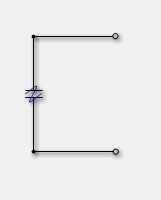A ![]() Nonlinear Capacitor circuit component definition applies nonlinear behavior to the component based on the instantaneous voltage across its cell edge.
Nonlinear Capacitor circuit component definition applies nonlinear behavior to the component based on the instantaneous voltage across its cell edge.
Nonlinear capacitors should be used when only time-domain results are of interest. This is because nonlinear capacitors violate the assumptions of linear system theory, making it incorrect to apply either a Fourier or discrete Fourier transform to the time-domain results. A simulation containing a nonlinear capacitor produces invalid frequency-domain results—including impedances, S-parameters, and steady-state far-zone fields—even if the time-domain results eventually decay to zero. The time-domain results are unaffected, and therefore are valid.
A nonlinear capacitor's behavior is defined by the following equation:
\begin{equation} C = C_2 + \frac{C_1 - C_2}{1 + a_1\left(\frac{ \vert V \vert - V_s}{V_0}\right)^2 + a_2\left(\frac {\vert V \vert - V_s}{V_0}\right)^4 + a_3\left(\frac {\vert V \vert - V_s}{V_0}\right)^6} \end{equation}where
$C = $ instantaneous cell edge capacitance
$V = $ instantaneous cell edge voltage
$C_1 = $ capacitance at the cutoff voltage
$C_2 = $ infinite $ \vert V \vert $ capacitance
$V_s = $ voltage magnitude
$V_0 = $ cutoff voltage. If $\vert V \vert \leq V_0$ then $C=C_1$.
$a_1$ , $a_2$ , $a_3$ are weighting coefficients

